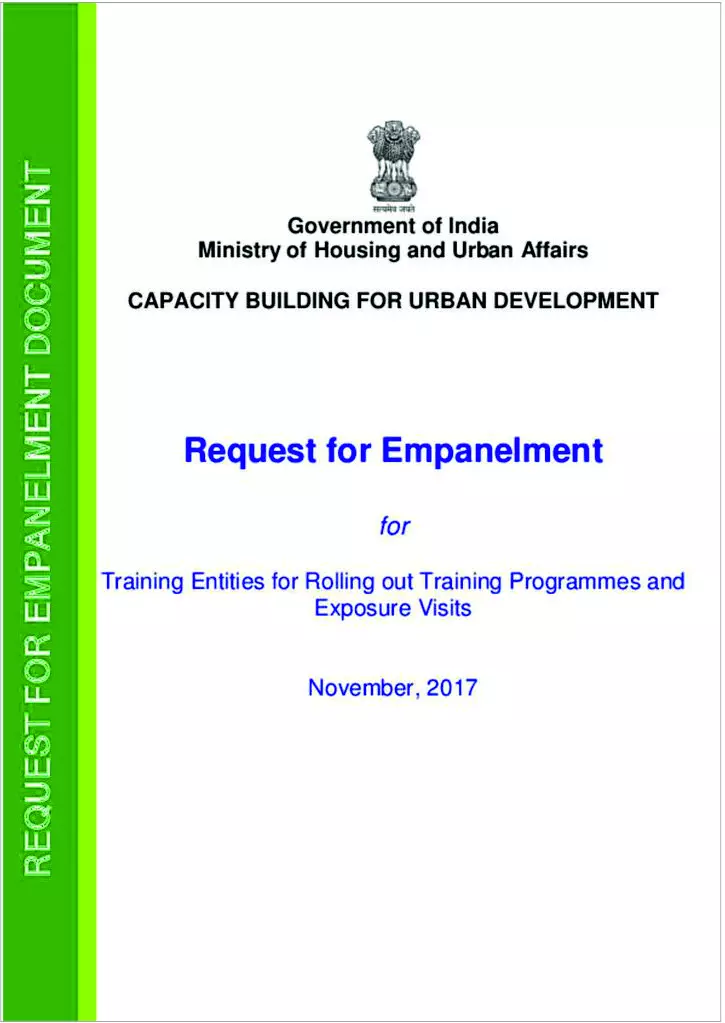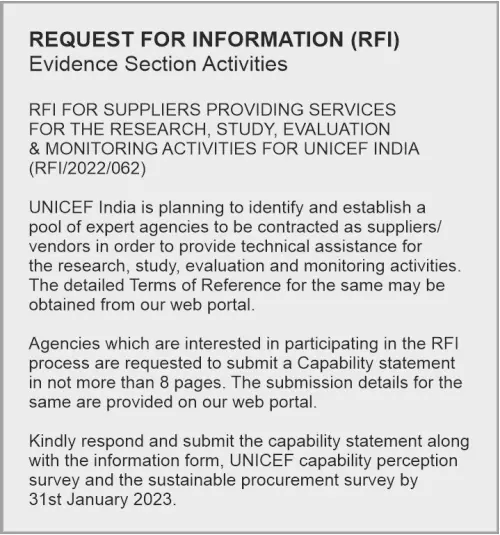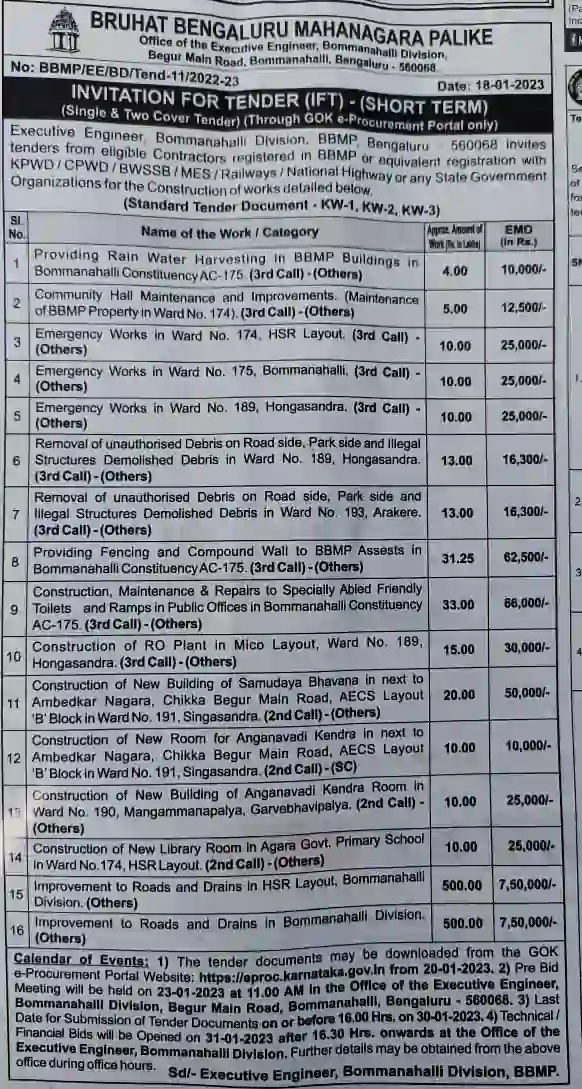- To procure Goods & Services, a Buyer invites Technical and Financial Proposals from the Sellers.
- The Sellers' Proposals are then Evaluated by the Buyer, and the One with the Most Suitable Offer is finally awarded the Work Contract.
- As Evaluation is based on both Quality and Cost, the Buyer is able to procure the desired Quality of Product/Service at Competitive Prices.
- The Evaluation Criteria is shared with Bidders at the start, which ensures Transparency and prevents Controversies.
Introduction
What is Competitive Bidding?

Bidding Process
Stages in Competitive Bidding
- Planning Stage: The Buyer wishing to procure any product or service from the market first decides its modalities, including an appropriate form of tendering instrument. Also, it decides whether to procure from the open market or from a smaller group of shortlisted sellers.
- Shortlisting Stage: If the Buyer decides to procure only from few selected Sellers, then it first calls for the Empanelment or Shortlisting based on the Expression of Interests (EoIs) submitted by the interested Sellers. Based on the Evaluation of these EoIs, the Buyer then shortlists a handful of Most Competent Sellers.
- Bidding/Proposal Stage: After shortlisting the Sellers, the Buyer invites Proposals from them. If the Buyer decides to Procure from the Open Market, then it skips the Shortlisting Stage and directly invites Proposals from all interested Sellers in the Market.
- Evaluation Stage: The Buyer then Evaluates the Proposals submitted by the Sellers, and Assigns them Marks, as per a pre-specified Criteria.
- Contracting Stage: The Seller Scoring the Highest Marks in the Proposal is finally Awarded the Work Contract.
1. Request for Expression of Interest (REOI): -
(A) Definition: -
An REOI is a document or notice issued by a Buyer (Govt. Dept., Institution, NGO, PSU, MNC, Pvt. Business, Cooperative, etc.) inviting interested Sellers to express their interest in a particular project or opportunity.
EOIs are typically used to gather information about potential vendors, suppliers, or contractors who may have the capability to meet the requirements of a project. This preliminary step helps organizations to identify potential bidders, understand the capabilities and expertise of the market, and to evaluate the level of interest in the opportunity.
An EOI usually contains information about the project, the scope of work, and the requirements that the organization is looking for. It may also include instructions for submitting responses, as well as any evaluation criteria that will be used to assess the submissions.
Submitting an EOI response does not guarantee that a vendor or contractor will be awarded the project or opportunity, but it is an important first step in the procurement process. The organization will use the information gathered from the EOI responses to evaluate potential vendors, and may then invite selected vendors to submit a more detailed proposal or bid.
(B) Rationale for Issuing REOI: -
An open tender usually attracts considerable number of bids/proposals from the suppliers. Quite often, these also include the ones submitted by the novices having only limited capability to deliver the required product/service. For winning the contract by any means, such agencies often resort to grossly underquoting their prices vis-à-vis their competitors, to the extent that the desired task may never be executed successfully with the quoted sum. Consequently, this lacuna risks jeopardising the entire project if such an agency is awarded the contract.
Thus, to put a curb on such practice, a two-stage selection process is adopted. In the first stage, the bidders are required to submit their Expression of Interest (EOI), outlining their capability and experiences. Only those shortlisted at this stage are then allowed to advance to the second stage in which they are allowed to submit their technical and financial bids.

2. Request for Empanelment (RFE): -
(A) Definition: -
An RFE typically refers to a request made by an individual or organization to be considered for inclusion on a panel or list of approved Sellers (product suppliers / service providers).The empanelment is done by the Buyer organisation as a preparatory work before executing projects or to meet regular annual consumption of supplies. This exercise is done to save time from those executing the project. The empanelled Sellers are also prepared to get the order and they can do their home work.
For example, a government agency may issue RFE to identify qualified vendors who can provide specific goods or services to the agency. Similarly, a company may issue a request for empanelment to identify potential consultants, contractors or suppliers to support their business operations.
The empanelment process typically involves a thorough review of the applicant's qualifications, credentials, experience, and other factors that may be relevant to the selection criteria. Once the evaluation process is complete, the panel or list is typically published and may be used by the organization to identify and engage with approved suppliers or service providers as and when needed.
(B) Rationale for Issuing RFE: -
Buyers are often faced with a situation wherein they need to procure some specialised product(s) or service(s) at frequent intervals over a period of time. For this they are anticipating that once the requirement arises it would need to be fulfilled within a very short window of time. However, at this stage they are not very sure of the exact nature and quantum of such demands.
In such situation, these buyers have two options. Either they initiate their procurement activity once the exact nature of requirements become known or they initiate the procurement activity at the start itself. In either case, they would face serious challenges. In the first one, there would be a very high chance of delays as procurement usually entails a lengthy process of competitive bidding, evaluation, negotiations, contracting and implementation. Also, it would unnecessarily push up the administrative cost burden as the same bidding cycle would have to be repeated in every round of procurement.
In the second case, the sellers might not be in a position to make advance commitment for delivering the required quantity and quality of products and/or services. Due to this, the sellers might not be too willing to enter into any sort of contract with this seller.
Thus, under such circumstances, instead of directly procuring from the open market such buyers adopt a two-stage procurement process. In the first stage, they empanel a few selected sellers willing to supply the required product(s) or service(s) as and when need arises. Under this, the credentials of interested sellers are verified in advance allowing for the empanelment of some 5-6 most qualified sellers. Later in the second stage, when the exact requirement is known, then technical and financial proposals are sought from only the few empanelled sellers. Thus, by having to evaluate the proposals of only a few selected sellers, such buyers are able to save lot of time and effort, including fiscal resources.

3. Request for Qualification (RQL): -
(A) Definition: -
A request for qualification (RQL) is a formal document used in procurement processes to invite potential vendors or contractors to demonstrate their qualifications and capabilities for a particular project or contract.
An RQL typically includes information about the project or contract requirements, the selection criteria, and the process for submitting a response. It may also request information on the vendor's financial stability, technical expertise, experience, and capacity to deliver the required goods or services.
An RQL is usually issued as part of a two-stage procurement process, where the first stage involves a pre-qualification or shortlisting of vendors based on their responses to the RQL. The shortlisted vendors are then invited to participate in the second stage of the procurement process, which may involve submitting a detailed proposal or bid.
(B) Rationale for Issuing RQL: -
The purpose of an RQL is to ensure that potential vendors or contractors are qualified and capable of delivering the required goods or services before they are invited to submit a detailed proposal or bid. This helps to streamline the procurement process and reduce the risk of selecting an unqualified or unsuitable vendor.

4. Request for Information (RFI): -
(A) Definition: -
A Request for Information (RFI) is a formal document or a communication method used by organizations or individuals to gather information from vendors or suppliers about the products or services they offer. An RFI is typically used in the early stages of a project or procurement process to gather information, clarify requirements, and identify potential vendors or solutions.
(B) Rationale for Issuing RFI: -
The purpose of an RFI is to collect information that will help the requester make informed decisions about the procurement process, such as selecting the most suitable vendors or suppliers, or determining the feasibility of a particular solution. RFIs may request information about a vendor's capabilities, experience, pricing, or other relevant information that may help the requester evaluate the vendor's suitability for the project.
Once the information is collected, the requester can use it to create a shortlist of vendors or suppliers to invite for further discussions or to create a more detailed request for proposal (RFP).

5. Request for Proposal (RfP): -
(A) Definition: -
A Request for Proposal (RFP) is a document that organizations or businesses use to solicit proposals from potential vendors or contractors for a specific project or initiative. The RFP outlines the requirements, goals, and scope of the project, and provides instructions on how to submit a proposal.
An RFP typically includes detailed information about the project, including the objectives, timeline, budget, evaluation criteria, and any specific requirements or qualifications that potential vendors must meet. Vendors are then invited to submit proposals in response to the RFP, which are evaluated by the organization issuing the RFP to determine the best fit for the project.
(B) Rationale for Issuing RFP: -
RFPs are commonly used in industries such as construction, information technology, marketing, and consulting, where organizations need to outsource work to third-party vendors.
By issuing an RFP, organizations can ensure that they receive competitive bids from a range of qualified vendors, and that they select the vendor who offers the best value for their needs.

6. Invitation for Tender (IFT) / Invitation to Tender (ITT): -
(A) Definition: -
An invitation for tender (IFT) is a formal request made by an organization or a company, typically a government agency or large corporation, inviting potential suppliers or contractors to submit bids or proposals to provide a specific product or service. The IFT is typically issued when the organization needs to purchase goods, works or services, and wants to get competitive pricing from multiple vendors.
The IFT typically includes information about the requirements and specifications of the product or service being sought, as well as the terms and conditions of the contract, including the timeline for submission of proposals, the evaluation criteria, and any other relevant information. The IFT is usually publicly advertised through various channels, such as online portals or newspapers, to attract as many potential suppliers or contractors as possible.
Once the bids are received, the organization will evaluate them and select the most suitable supplier or contractor based on various factors such as price, quality, and experience.
(B) Rationale for Issuing IFT: -
The primary rationale for issuing an invitation for tender (IFT) is to solicit competitive bids or proposals from potential suppliers or contractors for a specific project or requirement. Besides, it allows the Buyer to obtain a range of competitive bids or proposals from the Sellers who are interested in providing goods or services for the project. By soliciting bids from multiple Sellers, the Buyers can compare prices, evaluate the technical capabilities of potential Sellers, and ensure that they are getting the best value for their money.
Additionally, it provides a structured and transparent process for entering into a contract with an appropriate Seller. The IFT document sets out the criteria that will be used to evaluate bids, ensuring that all bidders are assessed on a level playing field. This can help to mitigate any potential bias or favoritism in the selection process, and ensure that the chosen supplier or contractor is the best fit for the project.
Overall, issuing an IFT is a best practice approach for Institutional Buyers looking to procure goods or services for a specific project, as it provides a fair and transparent process for selecting a Seller, while ensuring that the organization gets the best value for their money.

7. Notice Inviting Tender (NIT): -
(A) Definition: -
A notice inviting tender (NIT) is a formal announcement issued by a company or government agency, inviting bids from prospective suppliers or contractors to provide goods or services.
The NIT typically outlines the terms and conditions of the tender, including the deadline for submitting bids, the evaluation criteria, and the required specifications for the goods or services being procured. It also specifies the scope of work, the timeline, and other relevant details related to the project or service.
The notice inviting tender is usually published in local newspapers, online portals, and on the company or government agency's website to ensure a wide range of potential bidders are informed of the opportunity to bid. Once the bids are received, the company or government agency evaluates them based on the criteria specified in the NIT and awards the contract to the most suitable bidder.
(B) Rationale for Issuing NIT: -
The rationale behind issuing an NIT is to ensure transparency, fairness, and competitiveness in the procurement process.
Here are some of the key reasons why an organization might issue an NIT:
- To find the best value: By inviting multiple vendors to submit bids, the organization can evaluate multiple proposals and select the one that offers the best value for the project.
- To ensure fairness: An NIT ensures that all interested parties have equal opportunity to participate in the procurement process. This promotes a fair and transparent process that can minimize conflicts and disputes.
- To promote competition: By inviting multiple vendors to submit bids, an NIT creates a competitive environment that can encourage vendors to submit innovative proposals and competitive pricing.
- To comply with regulations: Many organizations are required by law to follow a competitive bidding process for certain types of procurement. An NIT helps to ensure compliance with these regulations.
- To minimize risks: By evaluating multiple proposals, an organization can identify potential risks and mitigate them before selecting a vendor.
Overall, issuing an NIT is a key step in the procurement process that can help organizations identify the best vendor for a project, while ensuring transparency, fairness, and compliance with regulations.

7. Request for Quotation (RfQ): -
(A) Definition: -
A Request for Quotation (RFQ) is a document that is typically used in procurement processes to request price quotes from Sellers for delivering specific products or services. The RFQ usually outlines the requirements for the goods or services, the expected delivery date, and the terms and conditions of the purchase.
The RFQ is typically used when the buyer already knows what they want to buy and is looking for competitive pricing from multiple Sellers. The Seller responds to the RFQ with a quotation that includes the price, delivery time, and any other relevant information.
The RFQ process can be used for a variety of products and services, from simple items like office supplies to more complex products like manufacturing equipment or construction materials. The main purpose of an RFQ is to compare pricing and terms from multiple Sellers and to ensure that the Buyer gets the best value for their money.
(B) Rationale for Issuing RfQ: -
The rationale for issuing an RFQ are:
- Cost Savings: An RFQ enables Buyers to compare prices and negotiate better deals with the Sellers. By inviting multiple Sellers to submit quotes, Buyers can choose the most cost-effective Seller and negotiate better prices.
- Competitive Bidding: The RFQ process fosters competition among Sellers, which can result in better quality goods or services at a lower price. This is because Sellers will be motivated to offer competitive prices to win the bid.
- Transparency: The RFQ process is transparent, and all Sellers have an equal opportunity to submit their quotes. This helps to avoid favoritism and ensure that the procurement process is fair and open.
- Standardization: An RFQ establishes a standard format for Sellers to submit their quotes, which facilitates the evaluation process. This makes it easier to compare and evaluate the different bids received.
- Efficiency: An RFQ process can save time and effort for both the Buyer and the Sellers. It eliminates the need for lengthy negotiations and reduces the administrative burden on both parties.
Overall, an RFQ process is a useful tool for Institutional Buyers to procure goods, services or works in a fair, transparent, and cost-effective manner.

